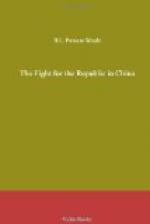Promptly at dawn on the 12th July a gun-signal heralded the assault. Large Republican contingents entered the city through various Gates, and a storm of firing aroused terror among the populace. The main body of Chang Hsun’s men, entrenched in the great walled enclosure of the Temple of Heaven, were soon surrounded, and although it would have been possible for them to hold out for several days, after a few hours’ firing a parley began and they quietly surrendered. Similarly in the Imperial city, where Chang Hsun had taken up his residence, this leader, in spite of his fire-eating declarations, soon fled to the Legation Quarter and besought an asylum. His men held out until two in the afternoon, when their resistance collapsed and the cease-fire sounded. The number of casualties on both sides was infinitesimal, and thus after eleven days’ farce the Manchu dynasty found itself worse off than ever before. It is necessary, however, not to lose sight of the main problem in China, which is the establishment of a united government and a cessation of internecine warfare,—issues which have been somewhat simplified by Chang Hsun’s escapade, but not solved. That a united government will ultimately be established is the writer’s belief, based on a knowledge of all the facts. But to attain that further provincial struggles are inevitable, since China is too large a unit to find common ground without much suffering and bitterness. President Li Yuan-hung having declared that nothing would induce him to resume office, Vice-President Feng Kuo-chang has become the legal successor and has quietly assumed office. Chang Hsun’s abortive coup has already cleared the air in North China to this extent: that the Manchu Imperial Family is to be removed from Peking and the Imperial allowance greatly reduced, whilst the proscription of such out-and-out imperialists as Kang Yu-wei has destroyed the last vestiges of public support. Finally the completion of China’s foreign policy, i.e. the declaration of war against Germany and Austria, has at last been made on the 14th August, 1917, and a consistent course of action mapped out.
[Illustration: The National Assembly sitting as a National Convention engaged on the Draft of the Permanent Constitution.
Specially photographed by permission of the Speakers for the Present Work.]
[Illustration: View from rear of Hall of the National Assembly sitting as a National Convention engaged on the Draft of the Permanent Constitution.
Specially photographed by permission of the Speakers for the Present Work.]
FOOTNOTES:
[25] The final text of the Permanent Constitution as it stood on the 28th May, 1917, will be found in the appendix. Its accuracy has been guaranteed to the writer by the speakers of the two Houses.
[26] Since this was written certain diplomatists in Peking have been forced to resign.




